Flash-Flood-Induced Changes in the Hydrochemistry of the Albufera of Valencia Coastal Lagoon
Abstract
1. Introduction
2. Materials and Methods
2.1. Study Zone
2.2. Hydrological Data
2.3. Sampling Methodology
2.4. Laboratory Analysis
2.5. Remote Sensing
2.6. Data Analysis
3. Results
3.1. Hydrology, Precipitation, and Rainfall
- Increase in volume in the lake: 19.32 × 106 m3;
- Increase in volume in the rice paddies: 86.5 × 106 m3;
- Average inflow to the whole of the Natural Park plus the lagoon on 30 October, including the estimated inflow-by-outflow of water during the hours when there is no increase in level, was 1525 m3 s−1;
- The maximum flow discharged to the sea on 1st November was 380 m3 s−1 without considering the possible inflows to the system by runoff from the flooded area outside the Natural Park, where the water level was not measured.
3.2. Hydrochemical Results
3.3. Statistical Analysis Results
3.4. Thematic Maps
4. Discussion
5. Conclusions
Author Contributions
Funding
Institutional Review Board Statement
Data Availability Statement
Conflicts of Interest
Abbreviations
| DANA | “Depresión aislada en niveles altos” (in Spanish), the translation is an isolated high-level atmospheric depression |
| TSS | Total suspended solids |
| LOI | Loss of ignition (organic solids) |
| TP | Total phosphorus |
| Chl-a | Chlorophyll-a |
| Car | Carotenoids |
| CDOM | Colored dissolved organic matter |
Appendix A
| Gauge Station | UTM X | UTM Y | Rainfall (mm) | Persistence (h) |
|---|---|---|---|---|
| Aliaguilla | 643422 | 4400560 | 160 | 4 |
| Alzira-La Casella | 721052 | 4336255 | 115 | 3 |
| Andilla | 687787 | 4409574 | 63 | 2 |
| Antella | 707982 | 4328433 | 87 | 2 |
| Benagéber * | 662946 | 4399134 | 249 | 9 |
| Bugarra | 690375 | 4386379 | 238 | 9 |
| Buseo | 676776 | 4384935 | 406 | 12 |
| Calles | 675275 | 4398542 | 200 | 8 |
| Carlet * | 712208 | 4344841 | 274 | 6 |
| Casinos | 696110 | 4396390 | 68 | 2 |
| Castelló_Ribera * | 714814 | 4326998 | 149 | 5 |
| Caudete_Fuentes | 649579 | 4377018 | 143 | 7 |
| Chelva | 672008 | 4404906 | 127 | 6 |
| Chiva | 694817 | 4369992 | 491 | 10 |
| Contreras | 629181 | 4377410 | 29 | 1 |
| Cortes_Pallás | 679391 | 4347985 | 73 | 3 |
| Cueva Santa | 704705 | 4413125 | 38 | 3 |
| Domeño | 675926 | 4396845 | 232 | 8 |
| Enguidanos | 619171 | 4393352 | 55 | 1 |
| Estubeny | 705846 | 4321601 | 21 | 1 |
| Forata | 684087 | 4356683 | 255 | 10 |
| Guadassuar | 718363 | 4342129 | 164 | 7 |
| Huerto Mulet | 723728 | 4340864 | 129 | 3 |
| La Muela | 678787 | 4345359 | 112 | 4 |
| Landete | 638503 | 4419060 | 130 | 7 |
| Loriguilla | 678994 | 4392754 | 71 | 1 |
| Manises | 714187 | 4377332 | 30 | 1 |
| Manuel | 716733 | 4324341 | 113 | 5 |
| Marines | 708415 | 4397655 | 37 | 1 |
| Millares | 695867 | 4343938 | 33 | 1 |
| Naranjero | 685094 | 4350037 | 220 | 8 |
| Pedralba | 699707 | 4386873 | 106 | 3 |
| Picassent | 716986 | 4363362 | 18 | 0 |
| Quart_Poblet | 720280 | 4373629 | 8 | 0 |
| Real_Montroy | 708911 | 4354134 | 244 | 6 |
| Requena | 661991 | 4371531 | 177 | 7 |
| Ribarroja | 707809 | 4372098 | 217 | 8 |
| Riola | 729852 | 4342428 | 10 | 0 |
| Salvacañete | 626486 | 4440355 | 77 | 2 |
| Sierra Ave | 691610 | 4352998 | 261 | 9 |
| Siete Aguas | 680661 | 4373122 | 291 | 11 |
| Sueca | 732542 | 4341308 | 10 | 0 |
| Tous | 703536 | 4334057 | 151 | 4 |
| Utiel | 660401 | 4388365 | 133 | 4 |
| Vilamarxant | 704385 | 4384009 | 142 | 3 |
| Villatoya | 643503 | 4354798 | 41 | 1 |
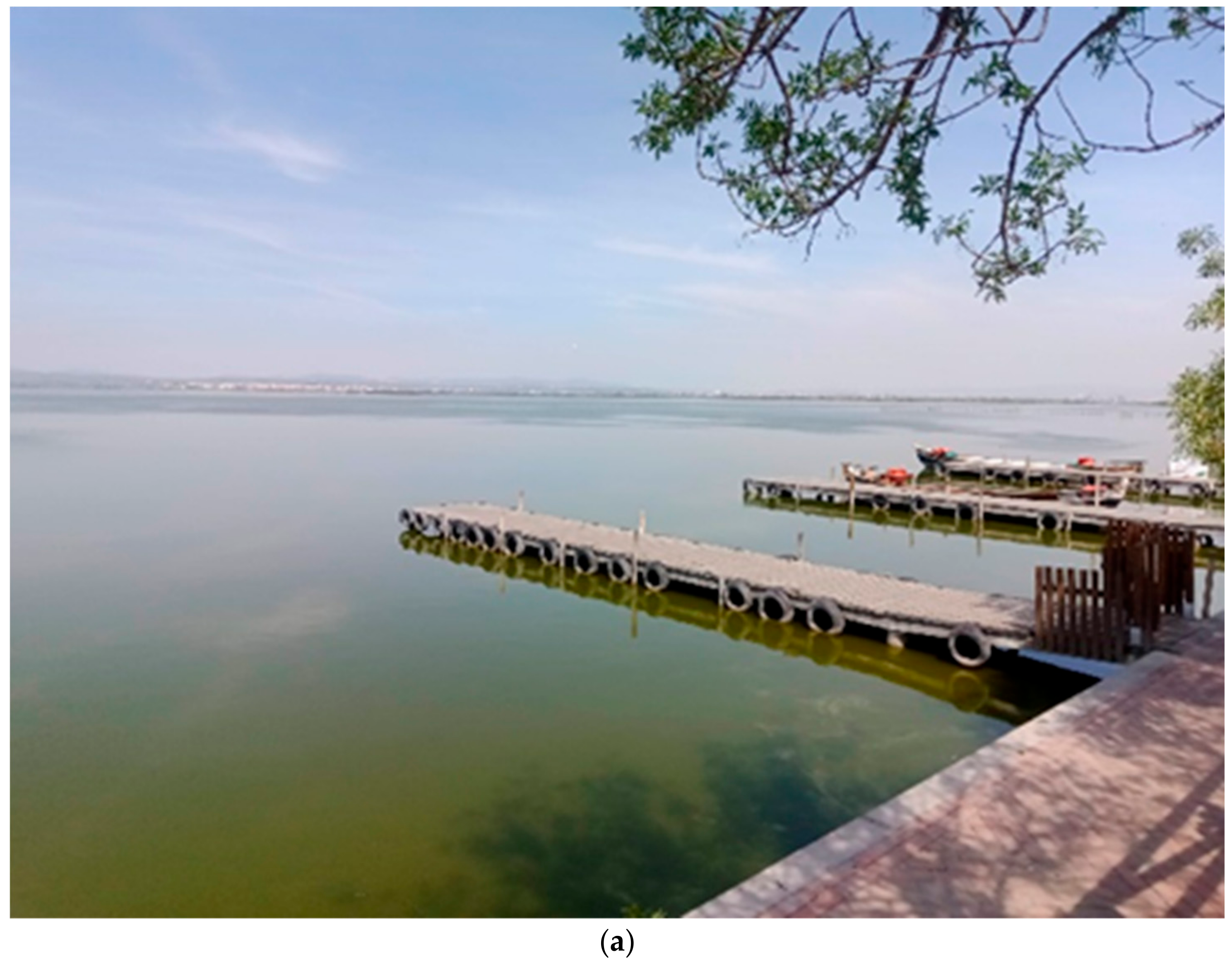
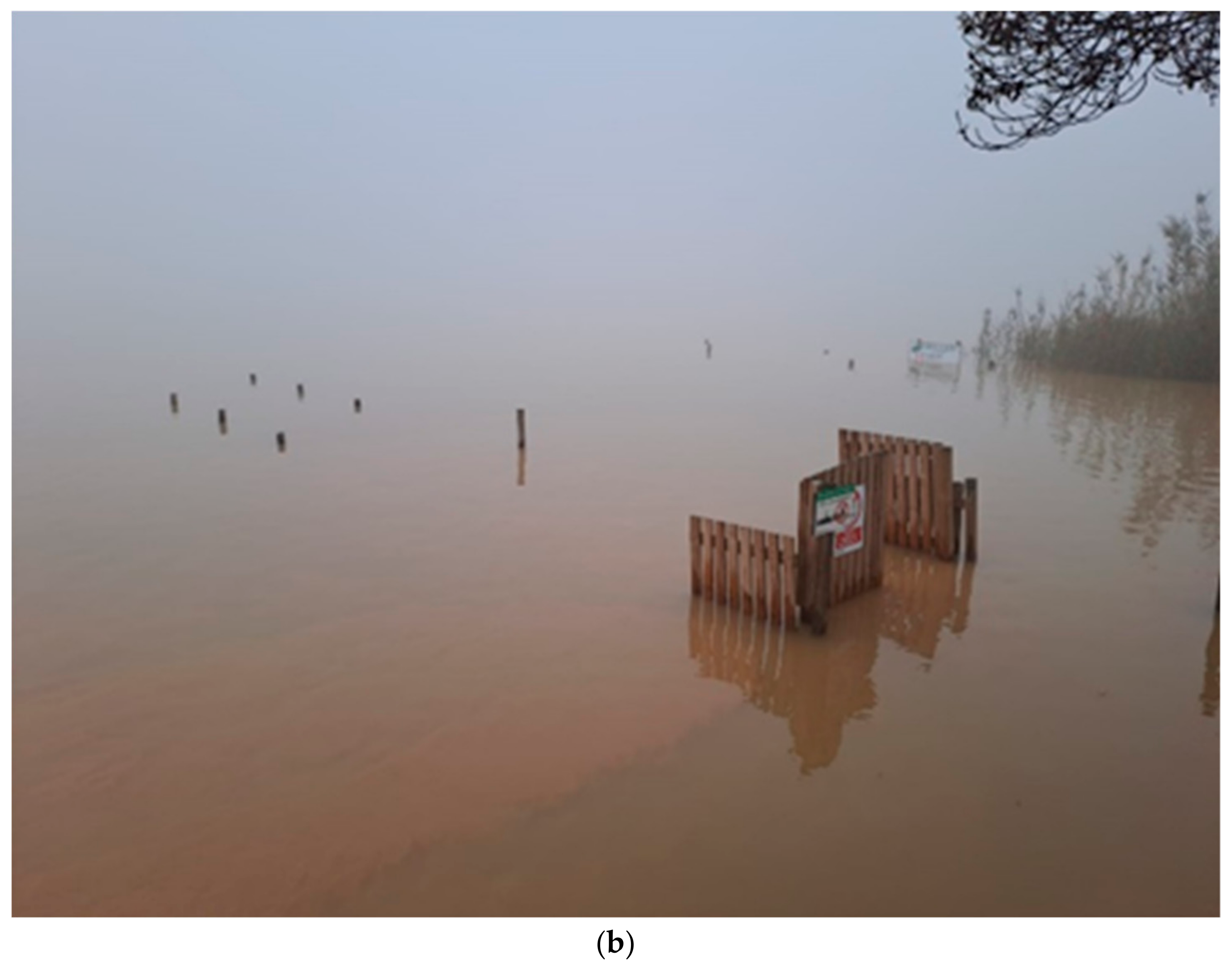
References
- Soria, J.M. Past, present and future of la Albufera of Valencia Natural Park. Limnetica 2006, 25, 135–142. [Google Scholar] [CrossRef]
- Rosselló, V.M. Los ríos Júcar y Turia en la génesis de la Albufera de Valencia. Cuad. De Geogr. 1972, 11, 7–25. Available online: http://hdl.handle.net/10550/30642 (accessed on 20 December 2024).
- López-Belzunce, M.; Blázquez, A.M.; Sánchez-Palencia, Y.; Torres, T.; Ortiz, J.E. Environmental evidence of Valencia lagoon coastal barrier stabilization from 8500 BP to Present. Climate and eustatic variations. Sci. Total Environ. 2022, 807, 151230. [Google Scholar] [CrossRef]
- Peris, T. La problemática génesis del segundo tramo de la acequia real del Xúquer: (orígenes de la «acequia del proyecto» del Duque de Híjar, 1728–1778). Investig. Geográficas 1991, 9, 167–190. [Google Scholar] [CrossRef]
- Jégou, A.; Sanchis-Ibor, C. The Opaque Lagoon. Water Management and Governance in l’Albufera de València Wetland (Spain). Limnetica 2019, 38, 503–515. [Google Scholar] [CrossRef]
- Marco-Barba, J.; Holmes, J.A.; Mesquita-Joanes, F.; Miracle, M.R. The influence of climate and sea-level change on the Holocene evolution of a Mediterranean coastal lagoon: Evidence from ostracod palaeoecology and geochemistry. Geobios 2013, 5, 409–421. [Google Scholar] [CrossRef]
- Rodrigo, M.A.; Alonso-Guillén, J.L.; Soulié-Märsche, I. Reconstruction of the former charophyte community out of the fructifications identified in Albufera de València lagoon sediments. Aquat. Bot. 2010, 92, 14–22. [Google Scholar] [CrossRef]
- Martín, M.; Hernández-Crespo, C.; Andrés-Doménech, I.; Benedito-Durá, V. Fifty years of eutrophication in the Albufera lake (Valencia, Spain): Causes, evolution and remediation strategies. Ecol. Eng. 2020, 155, 105932. [Google Scholar] [CrossRef]
- Vicente, E.; Miracle, M.R. The coastal lagoon Albufera de Valencia: An ecosystem under stress. Limnetica 1992, 8, 87–100. [Google Scholar] [CrossRef]
- Sòria-Perpinyà, X.; Miracle, M.R.; Soria, J.; Delegido, J.; Vicente, E. Remote sensing application for the study of rapid flushing to remediate eutrophication in shallow lagoons (Albufera of Valencia). Hydrobiologia 2019, 829, 125–132. [Google Scholar] [CrossRef]
- Soria, J.M.; Miracle, M.R.; Vicente, E. Relations between physico–chemical and biological variables in aquatic ecosystems of the Albufera Natural Park (Valencia, Spain). SIL Proc. 2002, 28, 564–568. [Google Scholar] [CrossRef]
- Soria, J.; Vera-Herrera, L.; Calvo, S.; Romo, S.; Vicente, E.; Sahuquillo, M.; Sòria-Perpinyà, X. Residence Time Analysis in the Albufera of Valencia, a Mediterranean Coastal Lagoon, Spain. Hydrology 2021, 8, 37. [Google Scholar] [CrossRef]
- Wu, J.; Luo, J.M.; Tang, L. Coupling Relationship between Urban Expansion and Lake Change—A Case Study of Wuhan. Water 2019, 11, 1215. [Google Scholar] [CrossRef]
- Pérez-Ruzafa, A.; Marcos-Diego, C.; Ros, J.D. Environmental and biological changes related to recent human activities in the Mar Menor (SE of Spain). Mar. Pollut. Bull. 1991, 23, 747–751. [Google Scholar] [CrossRef]
- Camarasa, A.; Segura, F. Flood events in Mediterranean ephemeral streams (ramblas) in Valencia region, Spain. Catena 2001, 45, 229–249. [Google Scholar] [CrossRef]
- Barredo, J.I. Major flood disasters in Europe: 1950–2005. Nat. Hazards 2007, 42, 125–148. [Google Scholar] [CrossRef]
- Faccini, F.; Luino, F.; Paliaga, G.; Sacchini, A.; Turconi, L.; de Jong, C. Role of rainfall intensity and urban sprawl in the 2014 flash flood in Genoa City, Bisagno catchment (Liguria, Italy). Appl. Geogr. 2018, 98, 224–241. [Google Scholar] [CrossRef]
- Sapountzis, M.; Stathis, D. Relationship between Rainfall and Run-off in the Stratoni Region (N. Greece) after the storm of 10th February 2010. Glob. NEST J. 2014, 16, 420–431. [Google Scholar] [CrossRef]
- Barriendos, M.; Gil-Guirado, S.; Pino, D.; Tuset, J.; Pérez-Morales, A.; Alberola, A.; Costa, J.; Balasch, J.C.; Castelltort, X.; Mazón, J.; et al. Climatic and social factors behind the Spanish Mediterranean flood event chronologies from documentary sources (14th–20th centuries). Glob. Planet. Change 2019, 182, 102997. [Google Scholar] [CrossRef]
- Centre for Research on the Epidemiology of Disasters (CRED). Emergency Events Database (EM-DAT). School of Public Health, Université Catholique de Louvain, Brussels, 2009. Available online: http://www.emdat.be/ (accessed on 16 December 2024).
- López-Martínez, F.; Gil-Guirado, S.; Pérez-Morales, A. Who can you trust? Implications of institutional vulnerability in flood exposure along the Spanish Mediterranean coast. Environ. Sci. Pol. 2017, 76, 29–39. [Google Scholar] [CrossRef]
- Jiménez, P.A.; González-Rouco, J.F.; Montávez, J.P.; García-Bustamantea, E.; Navarro, J. Climatology of wind patterns in the northeast of the Iberian Peninsula. Int. J. Climatol. 2009, 29, 501–525. [Google Scholar] [CrossRef]
- Grau-Bove, J.; Higha, R.; Orr, S.; Kumar, P. Short note on the mapping of heritage sites impacted by the 2024 floods in Valencia, Spain. arXiv 2024, arXiv:2411.08717. [Google Scholar]
- Faus, R.D. Exactions, Impact Fees, and Dedications--Local Government Responses to Nollan/Dolan Takings Law Issues. Stetson L. Rev. 1999, 29, 675–708. Available online: https://heinonline.org/HOL/Page?handle=hein.journals/stet29&collection=journals&id=689&startid=&endid=722 (accessed on 19 December 2024).
- SAIH-JUCAR. Available online: https://saih.chj.es/chj/saih/?f (accessed on 29 October 2024).
- APHA. Standard Methods for the Examination of Water and Wastewater, 18th ed.; American Public Health Association: Washington, DC, USA, 1992; p. 558. [Google Scholar]
- Shoaf, W.T.; Lium, B.W. Improved extraction of chlorophyll a and b from algae using dimethyl sulfoxide. Limnol. Oceanogr. 1976, 21, 926–928. [Google Scholar] [CrossRef]
- Jeffrey, S.T.; Humphrey, G.F. New spectrophotometric equations for determining chlorophylls a, b, c1 and c2 in higher plants, algae and natural phytoplankton. Biochem. Physiol. Pflanz. 1975, 167, 191–194. [Google Scholar] [CrossRef]
- Strickland, J.D.H.; Parsons, T.R. A Practical Handbook of Seawater Analysis; Fisheries Research Board of Canada: Ottawa, ON, Canada, 1972. [Google Scholar]
- Murphy, J.; Riley, J.P. A modified single-solution method for the determination of phosphorus in natural waters. Anal. Chim. Acta 1962, 27, 31–36. [Google Scholar] [CrossRef]
- Golterman, H.L.; Clymo, R.S.; Ohmstad, M. Methods for Physical and Chemical Analysis of Fresh Waters; IBP/Blackwell Scientific: Oxford, UK, 1978; p. 215. [Google Scholar]
- Crumpton, W.G.; Isenhart, T.M.; Mitchell, P.D. Nitrate and Organic N Analyses with Second-Derivative Spectroscopy. Limnol. Oceanogr. 1992, 37, 907–913. [Google Scholar] [CrossRef]
- European Spacial Agency (ESA). Sentinel-2: ESA’s Optical High-Resolution Mission for GMES Operational Services; Fletcher, K., Ed.; ESA Communications: Noordwijk, The Netherlands, 2012; p. 77. [Google Scholar]
- Soria-Perpinya, X.; Urrego, P.; Pereira-Sandoval, M.; Ruíz-Verdú, A.; Peña, R.; Soria, J.; Delegido, J.; Vicente, E.; Moreno, J. Monitoring the ecological state of a hypertrophic lake (Albufera of València, Spain) using multitemporal Sentinel-2 images. Limnetica 2019, 38, 457–469. [Google Scholar] [CrossRef]
- Molner, J.V.; Soria, J.M.; Pérez-González, R.; Sòria-Perpinyà, X. Measurement of Turbidity and Total Suspended Matter in the Albufera of Valencia Lagoon (Spain) Using Sentinel-2 Images. J. Mar. Sci. Eng. 2023, 11, 1894. [Google Scholar] [CrossRef]
- Molner, J.V.; Soria, J.M.; Pérez-González, R.; Sòria-Perpinyà, X. Estimating Water Transparency Using Sentinel-2 Images in a Shallow Hypertrophic Lagoon (The Albufera of Valencia, Spain). Water 2023, 15, 3669. [Google Scholar] [CrossRef]
- Agencia Estatal de Meteorología (AEMET). Informe Sobre el Episodio Meteorológico de Precipitaciones Torrenciales Persistentes Ocasionadas por una DANA el día 29 de Octubre de 2024. Ministerio para la Transición Ecológica y el Reto Demográfico (Gobierno de España), 2024; p. 13. Available online: https://www.aemet.es (accessed on 11 November 2024).
- Llasat, M.C.; Llasat-Botija, M.; Prat, M.A.; Porcu, F.; Price, C.; Mugnai, A.; Yair, Y. High-impact floods and flash floods in Mediterranean countries: The FLASH preliminary database. Adv. Geosci. 2010, 23, 47–55. [Google Scholar] [CrossRef]
- Cánovas, M. Avenidas motivadas por las lluvias extraordinarias de los días 13 y 14 de octubre de 1957. Rev. Obras. Públicas 1958, 106, 59–68. Available online: https://quickclick.es/rop/detalle_articulo.php?registro=13574&anio=1958&numero_revista=2914 (accessed on 17 December 2024).
- Romero-Aloy, M.J.; Almenar-Muñoz, M.; Fullana-Serra, V. En torno a la riada de 1957 en la ciudad de Valencia. Scr. Nova-Rev. Electron. De Geogr. Y Cienc. Soc. 2019, 23, 622. [Google Scholar] [CrossRef]
- Puertes, C. La Riada de Valencia de Octubre de 1957: Reconstrucción Hidrológica y Sedimentológica y Análisis Comparativo con la Situación Actual. Undergraduate Thesis, Polytechnic University of Valencia, Valencia, Spain, 2015. [Google Scholar]
- Torcal, F.; Serrano, I.; Havskov, J.; Utrillas, J.L.; Valero, J. Induced seismicity around the Tous New Dam (Spain). Geophys. J. Int. 2005, 160, 144–160. [Google Scholar] [CrossRef]
- Alcrudo, F.; Mulet, J. Description of the Tous Dam Break Case Study (Spain). J. Hydraul. Res. 2007, 45, 45–57. [Google Scholar] [CrossRef]
- Rosselló, V.M. La revinguda del Xúquer i el desastre de la Ribera. 20–21 octubre 1982: Una perspectiva geogràfica. Cuadernos de Geografía 1983, 32–33, 3–38. Available online: http://hdl.handle.net/10550/30801 (accessed on 9 December 2024).
- Serra-Llobet, A.; Tàbara, J.D.; Sauri, D. The Tous dam disaster of 1982 and the origins of integrated flood risk management in Spain. Nat. Hazards 2013, 65, 1981–1998. [Google Scholar] [CrossRef]
- Botella, A.; Salom, J. Las inundaciones del Xúquer en 1982: Repercusiones en el sector industrial. Cuad. De Geogr. 1983, 32–33, 187–212. Available online: http://hdl.handle.net/10550/30803 (accessed on 9 December 2024).
- Plan de Acción Territorial de Carácter Sectorial Sobre Prevención del Riesgo de Inundación en la Comunidad Valenciana (PATRICOVA). Available online: http://www.cma.gva.es/areas/urbanismo_ordenacion/infadm/publicaciones/pdf_patricova/indice.htm (accessed on 20 December 2024).
- Government Department of the Generalitat Valenciana (GDGV). Campaña de Prevención de Inundaciones. Document Divulgatiu; GDGV: Valencia, Spain, 2009. (In Spanish)
- Valencian Cartographic Institute. Available online: https://visor.gva.es/visor/ (accessed on 23 December 2014).
- Argence, S.; Lambert, D.; Richard, E.; Söhne, N.; Chaboureau, J.P.; Crépin, F.; Arbogast, P. High resolution numerical study of the Algiers 2001 flash flood: Sensitivity to the upper-level potential vorticity anomaly. Adv. Geosci. 2006, 7, 251–257. [Google Scholar] [CrossRef][Green Version]
- Legrand, P.; Brugnot, G.; Baumont, G. Rétour d’experience des inondations de septembre de 2002 dans les départaments du Gard, de l’Hérault, du Vaucluse, des Bouches de Rhône, de l’Ardèche et de la Drôme. Contribution du Groupe d’Appui et d’expertise scientifique 2003 (on CD-ROM). Available online: https://www.vie-publique.fr/files/rapport/pdf/034000547.pdf (accessed on 18 December 2024).
- Dronkers, J.; Zimmerman, J.T.F. Some principles of mixing in tidal lagoons. Oceanol. Acta 1982, 4, 107–118. Available online: https://archimer.ifremer.fr/doc/00246/35736/ (accessed on 18 December 2024).
- Monsen, N.E.; Cloern, J.E.; Lucas, L.V.; Monismith, S.G. A comment on the use of flushing time, residence time, and age as transport time scales. Limnol. Oceanogr. 2002, 47, 1545–1553. [Google Scholar] [CrossRef]
- Soria, J.; Romo, S.; Vera-Herrera, L.; Calvo, S.; Sòria-Perpinyà, X. Evolución de la conductividad en la Albufera de Valencia entre 1985 y 2018. Limnetica 2021, 40, 223–232. [Google Scholar] [CrossRef]
- Soria, J.M.; Vicente, E.; Miracle, M.R. The influence of flash floods on the limnology of the Albufera of Valencia lagoon (Spain). SIL Proc. 1922–2010 2000, 27, 2232–2235. [Google Scholar] [CrossRef]
- Bijay-Singh; Craswell, E. Fertilizers and nitrate pollution of surface and ground water: An increasingly pervasive global problem. SN Appl. Sci. 2021, 3, 518. [Google Scholar] [CrossRef]
- Machado Toffolo, M.; Grilli, F.; Prandi, C.; Goffredo, S.; Marini, M. Extreme Flooding Events in Coastal Lagoons: Seawater Parameters and Rainfall over A Six-Year Period in the Mar Menor (SE Spain). J. Mar. Sci. Eng. 2022, 10, 1521. [Google Scholar] [CrossRef]
- Castaño-Ortiz, J.M.; Gil-Solsona, R.; Ospina-Alvarez, N.; García-Pimentel, M.D.M.; León, V.M.; Santos, L.H.M.L.M.; Barceló, D.; Rodríguez-Mozaz, S. Bioaccumulation and fate of pharmaceuticals in a Mediterranean coastal lagoon: Temporal variation and impact of a flash flood event. Environ. Res. 2023, 228, 115887. [Google Scholar] [CrossRef]
- Walukow, A.F.; Triwiyono; Sukarta, I.N. Conceptual model of water pollution control strategies in the lower Sentani watershed post flash flood using the swot method. Ecol. Eng. Environ. Technol. 2022, 23, 120–129. [Google Scholar] [CrossRef]
- Ntangyong, I.L.; Chaigneau, A.; Morel, Y.; Assogba, A.; Okpeitcha, V.O.; Duhaut, T.; Stieglitz, T.; Van Beek, P.; Baloitcha, E.; Sohou, Z.; et al. Seasonal and Interannual Variations of Suspended Particulate Matter in a West-African Lagoon (Nokoué Lagoon, Benin): Impact of Rivers and Wind. Estuar. Coast. Shelf Sci. 2024, 304, 108821. [Google Scholar] [CrossRef]
- Courboulès, J.; Vidussi, F.; Soulié, T.; Nikiforakis, E.; Heydon, M.; Mas, S.; Joux, F.; Mostajir, B. Effects of an experimental terrestrial runoff on the components of the plankton food web in a Mediterranean coastal lagoon. Front. Mar. Sci. 2023, 10, 1200757. [Google Scholar] [CrossRef]
- Ligorini, V.; Garrido, M.; Malet, N.; Simon, L.; Alonso, L.; Bastien, R.; Aiello, A.; Cecchi, P.; Pasqualini, V. Response of Phytoplankton Communities to Variation in Salinity in a Small Mediterranean Coastal Lagoon: Future Management and Foreseen Climate Change Consequences. Water 2023, 15, 3214. [Google Scholar] [CrossRef]


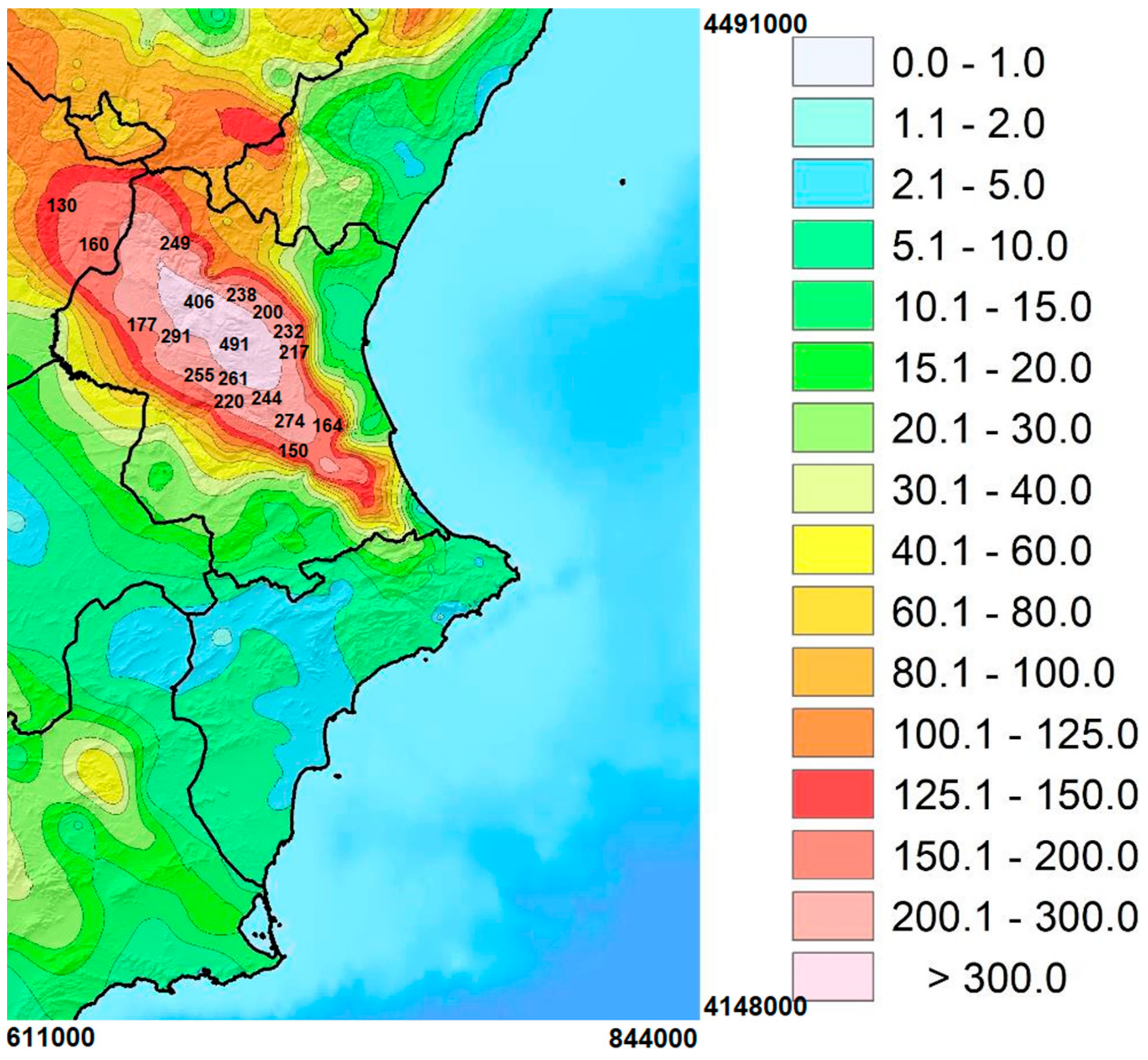
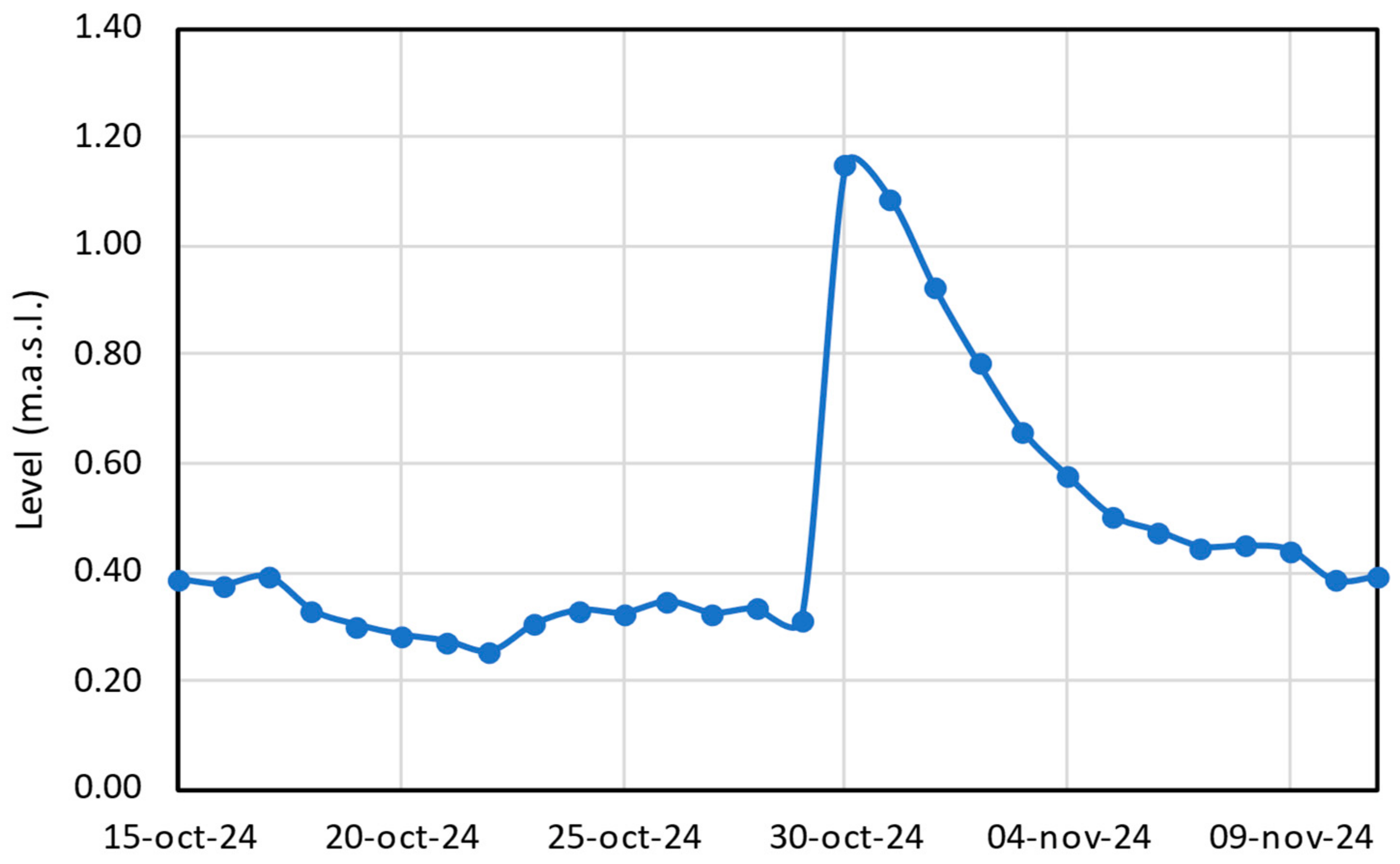
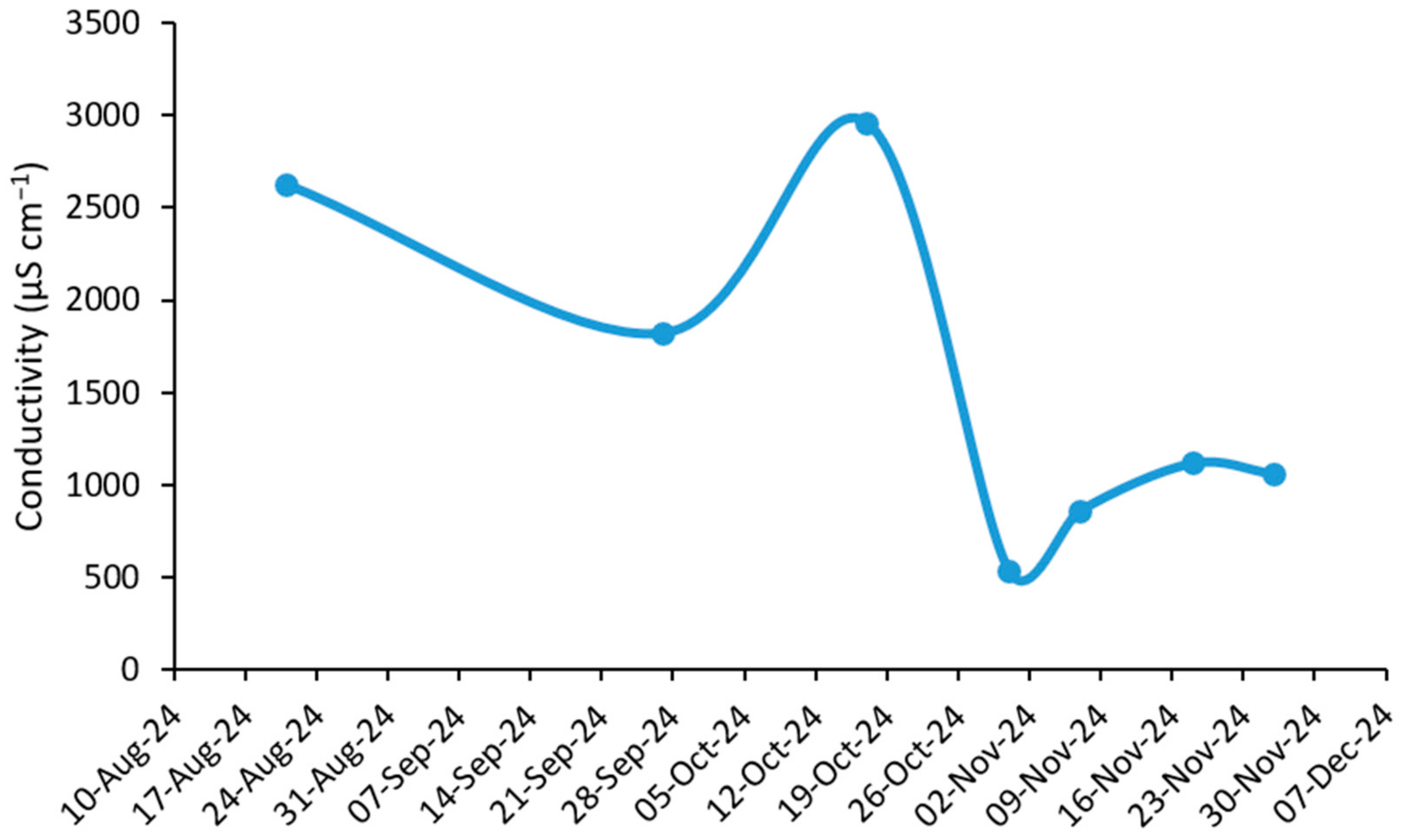
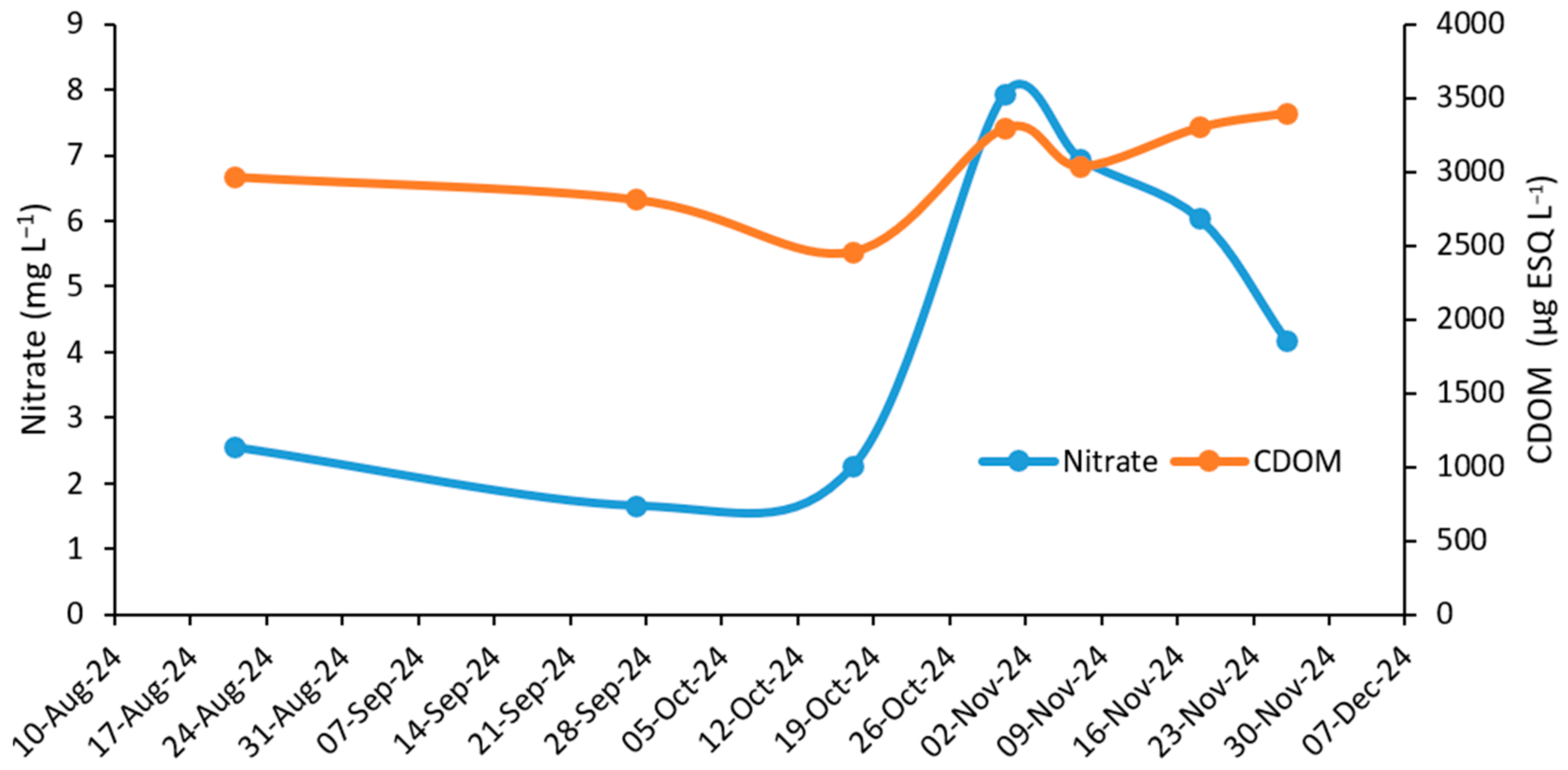
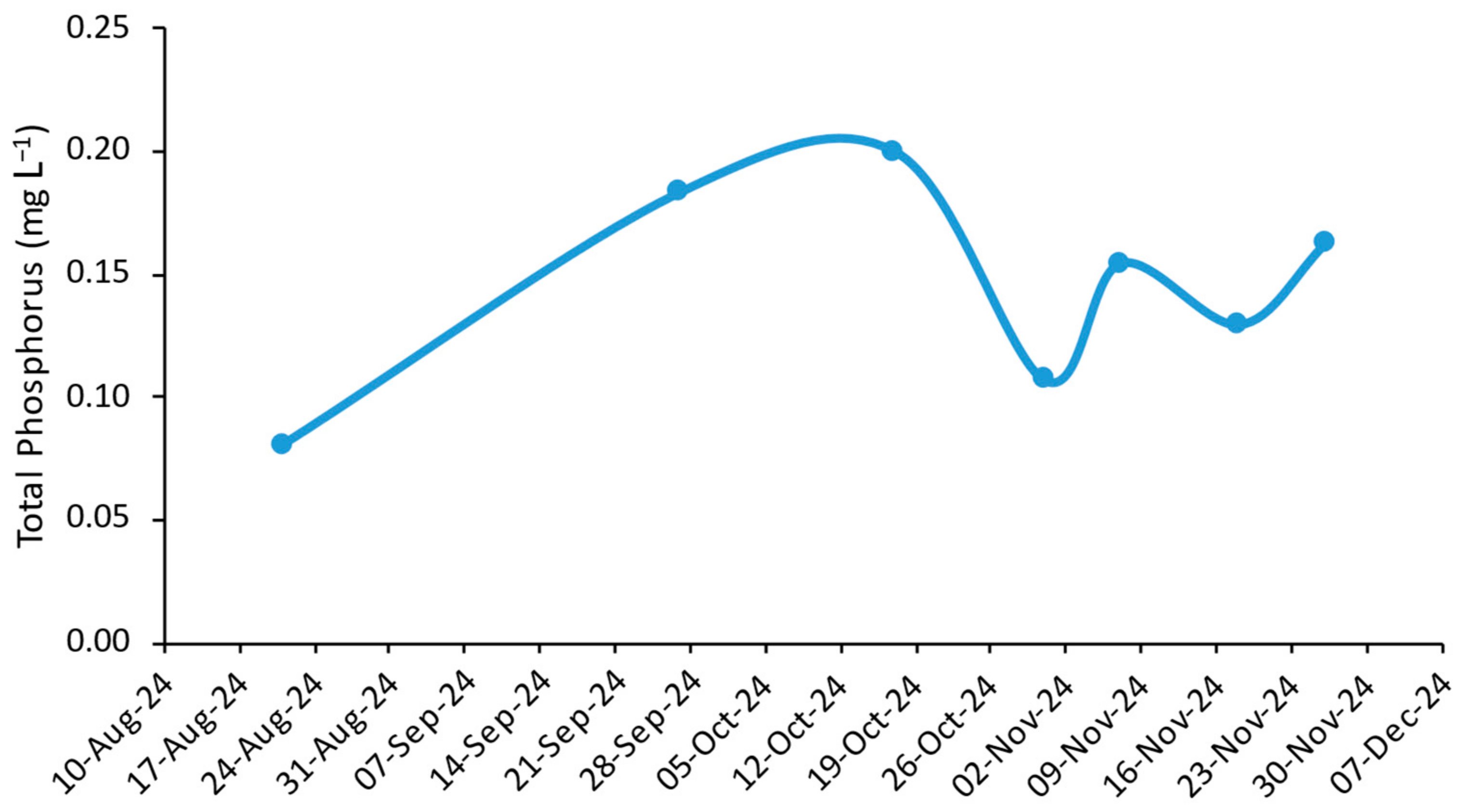
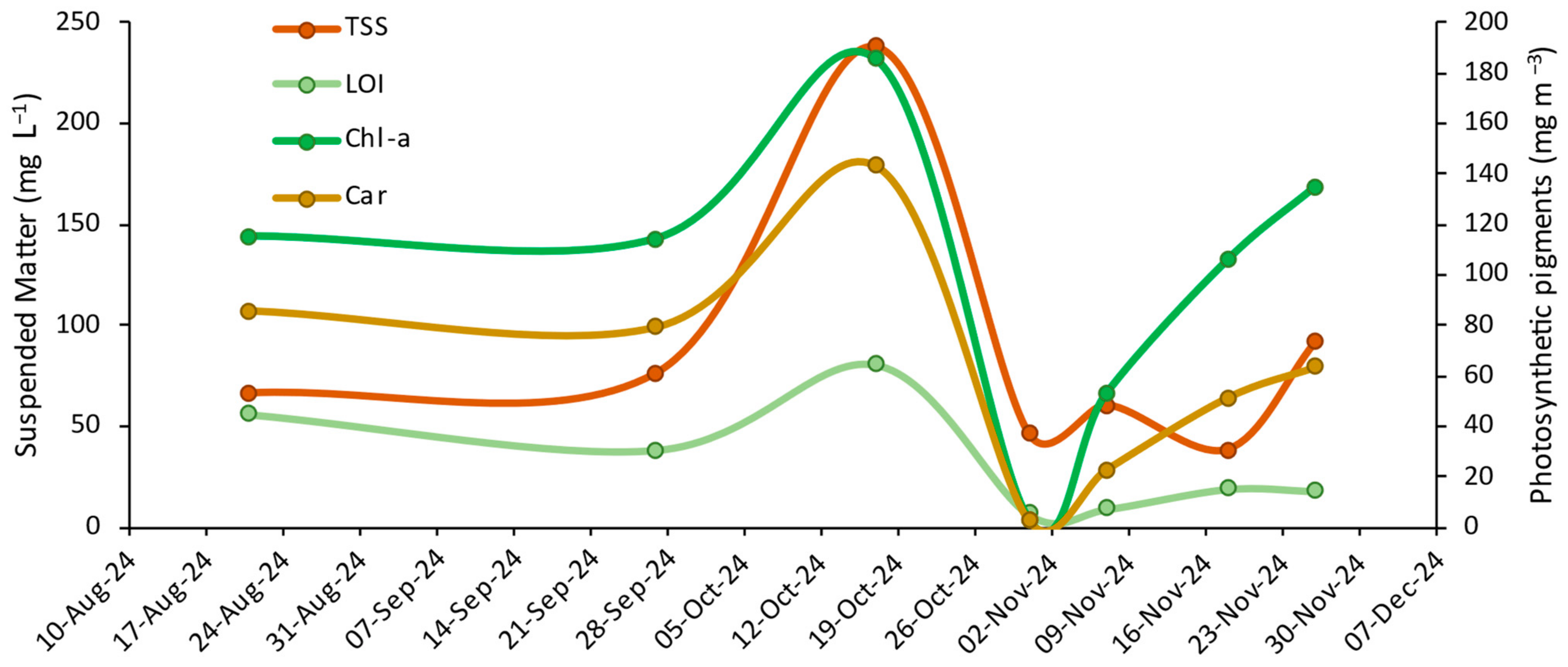

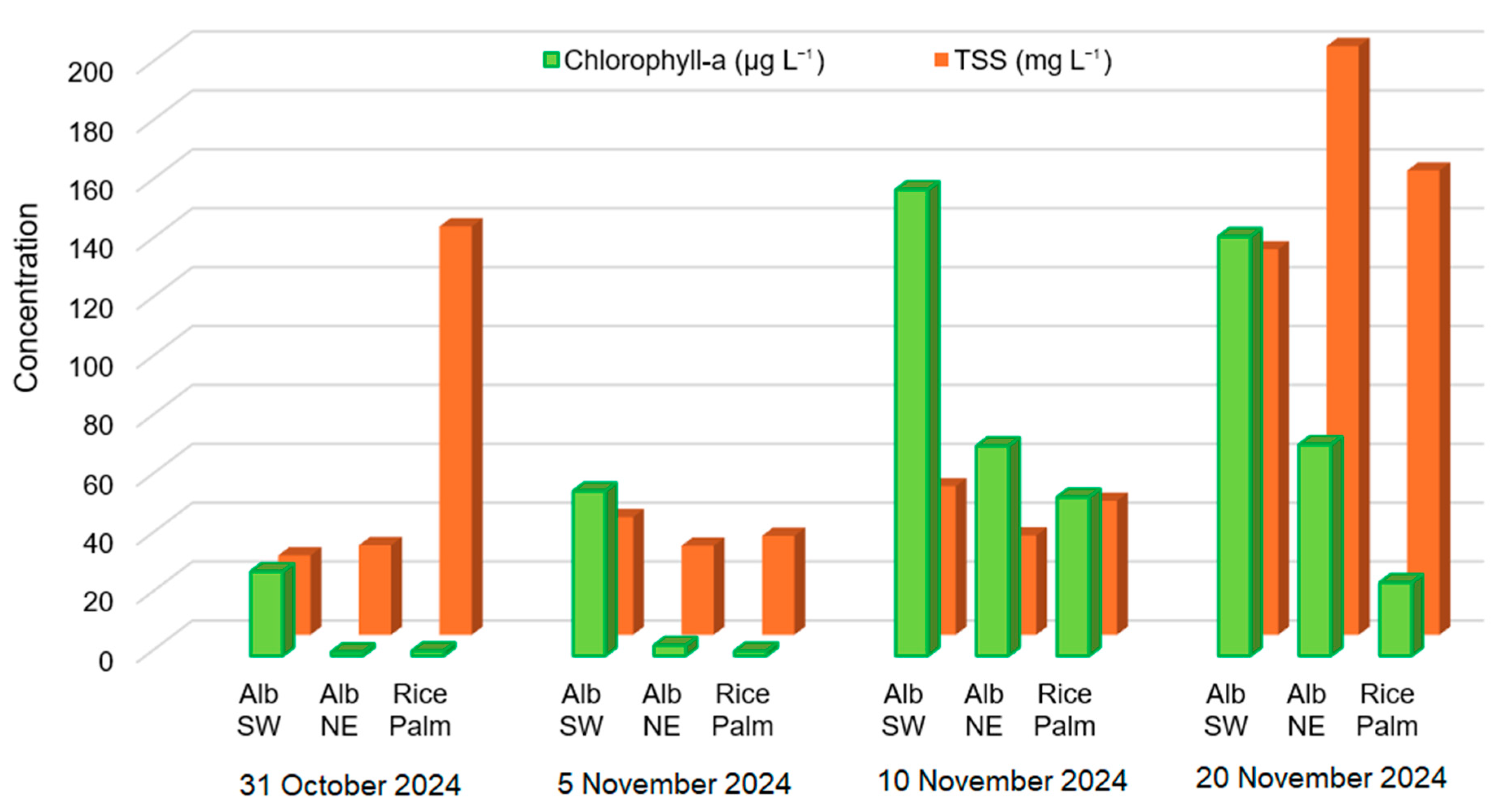
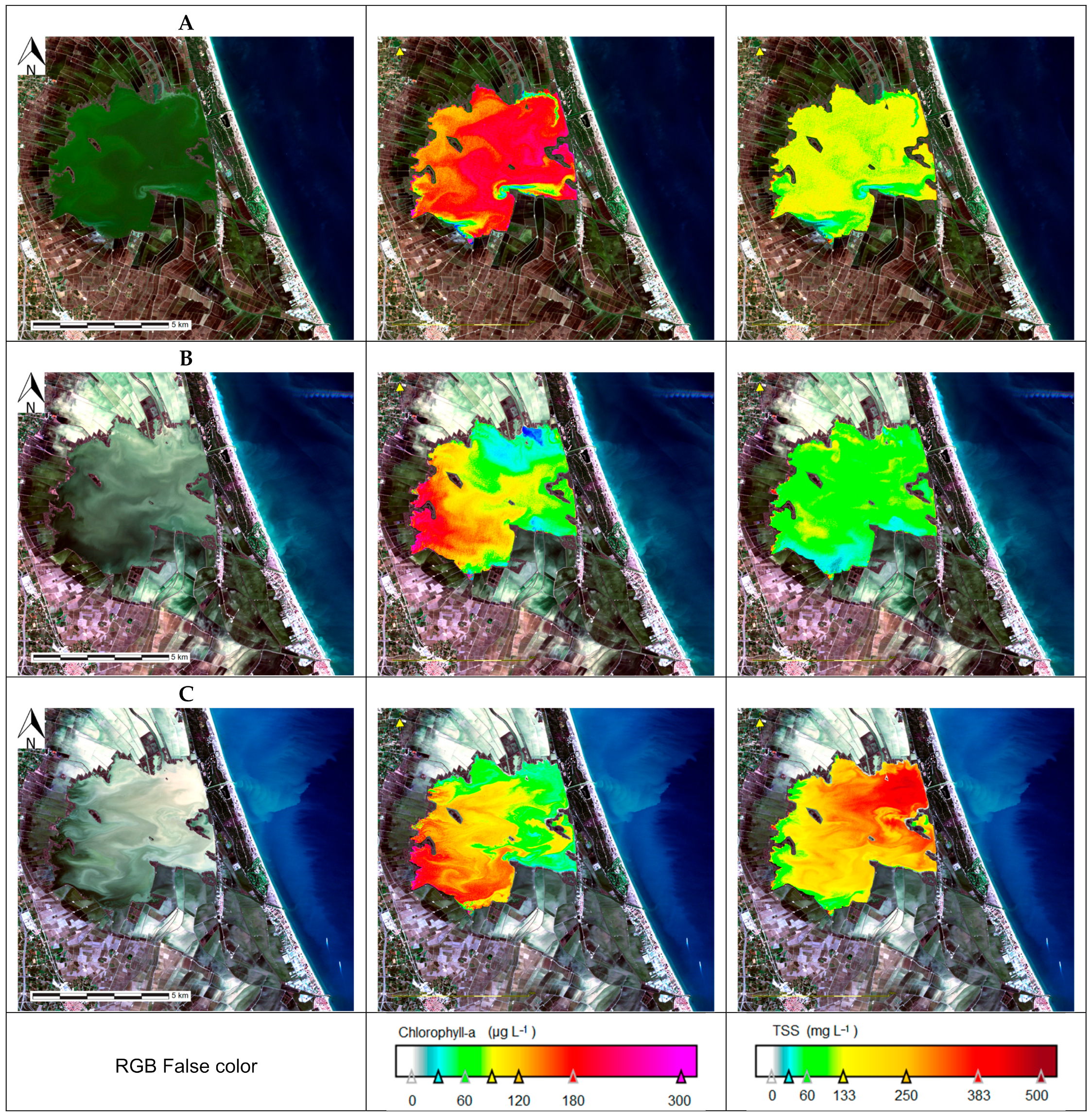
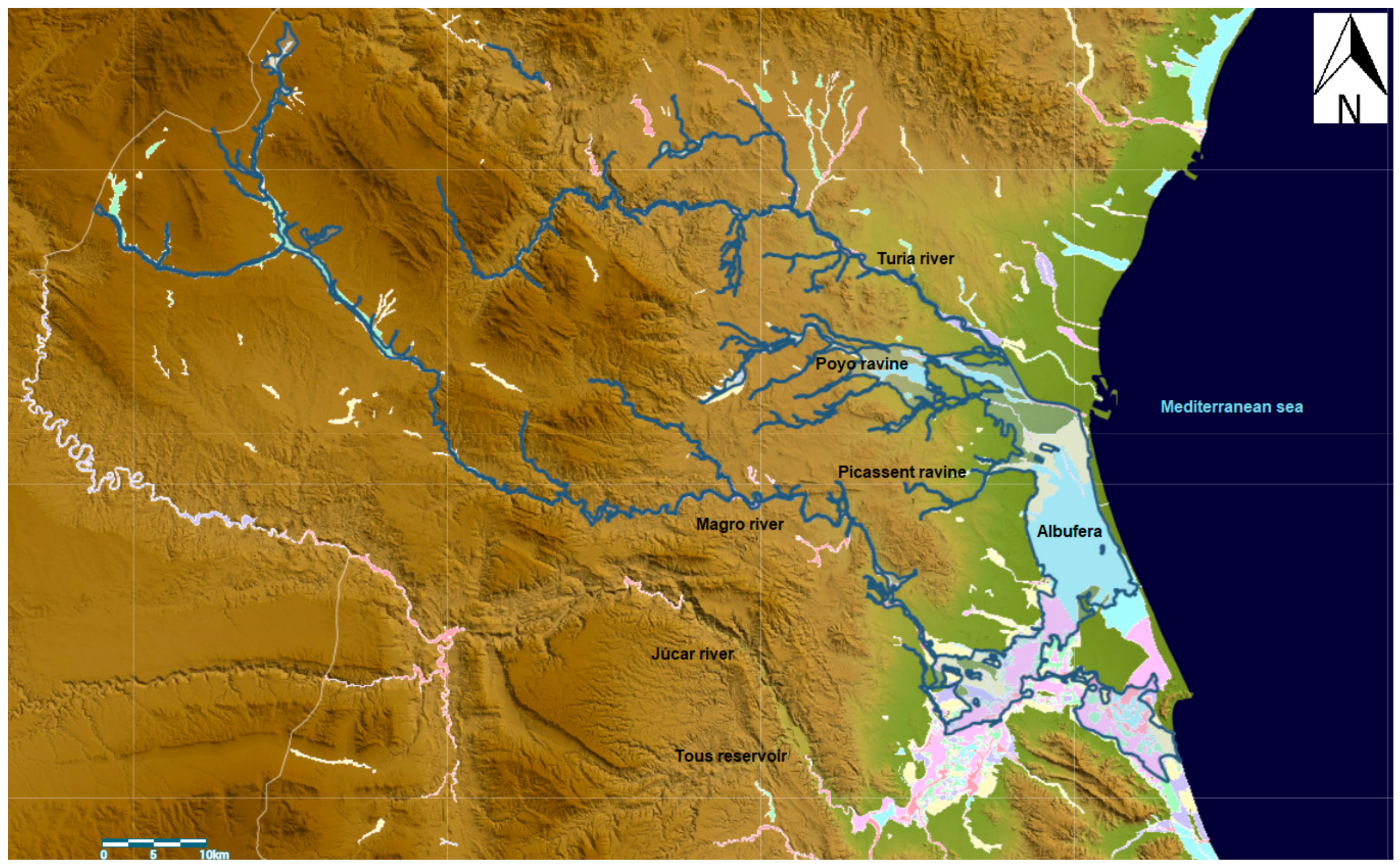
| Date | Tª (°C) | pH | Cond (µS cm−1) | TSS (mg L−1) | LOI (mg L−1) | Chl-a (mg m−3) | Nitrate (mg L−1) | TP (mg L−1) | Car (mg m−3) | CDOM (µg ESQ L−1) |
|---|---|---|---|---|---|---|---|---|---|---|
| 21 August 2024 | 29.9 | 8.4 | 2626 | 66.00 | 55.80 | 115.15 | 2.56 | 0.08 | 85.59 | 2966.13 |
| 27 September 2024 | 22.6 | 8.0 | 1821 | 75.69 | 38.15 | 114.05 | 1.66 | 0.18 | 78.99 | 2812.77 |
| 17 October 2024 | 21.4 | 8.4 | 2961 | 237.69 | 80.26 | 185.27 | 2.26 | 0.20 | 143.14 | 2458.90 |
| 31 October 2024 | 20.2 | - | 539 | 45.60 | 6.37 | 2.81 | 7.94 | 0.11 | 2.06 | 3297.69 |
| 07 November 2024 | 22.4 | 7.5 | 861 | 60.18 | 8.96 | 52.70 | 6.96 | 0.15 | 22.36 | 3038.47 |
| 18 November 2024 | 16.9 | 8.4 | 1117 | 38.00 | 18.90 | 105.52 | 6.04 | 0.13 | 50.90 | 3302.61 |
| 26 November 2024 | - | 8.1 | 1060 | 91.13 | 17.93 | 134.60 | 4.18 | 0.16 | 63.08 | 3399.26 |
Disclaimer/Publisher’s Note: The statements, opinions and data contained in all publications are solely those of the individual author(s) and contributor(s) and not of MDPI and/or the editor(s). MDPI and/or the editor(s) disclaim responsibility for any injury to people or property resulting from any ideas, methods, instructions or products referred to in the content. |
© 2025 by the authors. Licensee MDPI, Basel, Switzerland. This article is an open access article distributed under the terms and conditions of the Creative Commons Attribution (CC BY) license (https://creativecommons.org/licenses/by/4.0/).
Share and Cite
Soria, J.M.; Muñoz, R.; Campillo-Tamarit, N.; Molner, J.V. Flash-Flood-Induced Changes in the Hydrochemistry of the Albufera of Valencia Coastal Lagoon. Diversity 2025, 17, 119. https://doi.org/10.3390/d17020119
Soria JM, Muñoz R, Campillo-Tamarit N, Molner JV. Flash-Flood-Induced Changes in the Hydrochemistry of the Albufera of Valencia Coastal Lagoon. Diversity. 2025; 17(2):119. https://doi.org/10.3390/d17020119
Chicago/Turabian StyleSoria, Juan M., Rafael Muñoz, Noelia Campillo-Tamarit, and Juan Víctor Molner. 2025. "Flash-Flood-Induced Changes in the Hydrochemistry of the Albufera of Valencia Coastal Lagoon" Diversity 17, no. 2: 119. https://doi.org/10.3390/d17020119
APA StyleSoria, J. M., Muñoz, R., Campillo-Tamarit, N., & Molner, J. V. (2025). Flash-Flood-Induced Changes in the Hydrochemistry of the Albufera of Valencia Coastal Lagoon. Diversity, 17(2), 119. https://doi.org/10.3390/d17020119








